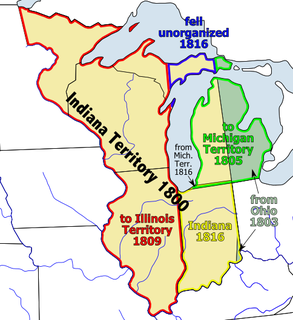
Since Hawaii became a state in 1959, it has sent congressional delegations to the United States Senate and United States House of Representatives. Each state elects two senators to serve for six years. Members of the House of Representatives are elected to two-year terms, one from each of Hawaii's congressional districts. Before becoming a state, the Territory of Hawaii elected a non-voting delegate at-large to Congress from 1900 to 1958.

The District of Columbia's at-large congressional district is a congressional district based entirely of the District of Columbia. According to the U.S. Constitution, only states may be represented in the Congress of the United States. The District of Columbia is not a U.S. state and therefore has no voting representation. Instead, constituents in the district elect a non-voting delegate to the U.S. House of Representatives.

George Wallace Jones was an American frontiersman, entrepreneur, attorney, and judge, was among the first two United States Senators to represent the state of Iowa after it was admitted to the Union in 1846. A Democrat who was elected before the birth of the Republican Party, Jones served over ten years in the Senate, from December 7, 1848 to March 3, 1859. During the American Civil War, he was arrested by Federal authorities and briefly jailed on suspicion of having pro-Confederate sympathies.

The Territory of Iowa was an organized incorporated territory of the United States that existed from July 4, 1838, until December 28, 1846, when the southeastern portion of the territory was admitted to the Union as the state of Iowa. The remainder of the territory would have no organized territorial government until the Minnesota Territory was organized on March 3, 1849.

The Territory of Wisconsin was an organized incorporated territory of the United States that existed from July 3, 1836, until May 29, 1848, when an eastern portion of the territory was admitted to the Union as the State of Wisconsin. Belmont was initially chosen as the capital of the territory. In 1837, the territorial legislature met in Burlington, just north of the Skunk River on the Mississippi, which became part of the Iowa Territory in 1838. In that year, 1838, the territorial capital of Wisconsin was moved to Madison.

The 1868 and 1869 United States House of Representatives elections coincided with the 1868 United States presidential election, which was won by Ulysses S. Grant.

The 1838 and 1839 United States House of Representatives elections were held during President Martin Van Buren's term at various dates in different states from July 1838 to November 1839.

The Indiana Territory's at-large congressional district encompassed the entire area of the Indiana Territory.

Illinois Territory's at-large congressional district was a congressional district that encompassed the entire Illinois Territory. The territory was established on March 1, 1809 from portions of Indiana Territory. The district elected a non-voting delegate to the United States House of Representatives.

Alaska Territory's at-large congressional district was a congressional district created in 1906 to represent the District of Alaska, which was reorganized into the Alaska Territory in 1912. After Alaska's admission to the Union as the 49th state by act of Congress on January 3, 1959, this district evolved into Alaska's at-large congressional district.

Oregon Territory's at-large congressional district is an obsolete congressional district that encompassed the area of the Oregon Territory. In 1853, the northern half of the territory was reorganized into the Washington Territory.
The Oklahoma Territory's at-large congressional district is a defunct congressional district that was created by the Organic Act of 1890 and ended with Oklahoma statehood. One delegate was to be sent to the U.S. House of Representatives from Oklahoma Territory.

Hawaii Territory's at-large congressional district was the congressional district for the Territory of Hawaii, which was established by the Newlands Resolution of 1898.

Idaho Territory's at-large congressional district is an obsolete congressional district that encompassed the area of the Idaho Territory, which was originally created from parts of the Washington Territory and Dakota Territory in 1863. In 1864, parts of the territory were ceded back to the Dakota Territory and another part was reorganized into the Montana Territory. The boundaries of the territory were changed again in 1868 when the Wyoming Territory was created.

New Mexico Territory's at-large congressional district is an obsolete congressional district representing the New Mexico Territory, which was created in 1850. After New Mexico's admission to the Union as the 47th state by act of Congress on January 6, 1912, this district was dissolved and replaced by New Mexico's at-large congressional district.

Wyoming Territory's at-large congressional district is an obsolete congressional district that encompassed the area of the Wyoming Territory. After Wyoming's admission to the Union as the 44th state by act of Congress on July 10, 1890, this district was dissolved and replaced by Wyoming's at-large congressional district.
Utah Territory's at-large congressional district is an obsolete congressional district that encompassed the area of the Utah Territory. After Utah's admission to the Union as the 45th state by act of Congress on January 4, 1896, this district was dissolved and replaced by Utah's at-large congressional district.
From December 28, 1846, to March 3, 1847, the new state of Iowa was represented in the United States House of Representatives by two representatives who had been elected on a statewide basis, rather than by districts.

Nevada Territory's at-large congressional district is an obsolete congressional district that encompassed the area of the Nevada Territory, which was split off from the Utah Territory in 1861. After Nevada's admission to the Union as the 36th state by act of Congress on October 31, 1864, this district was dissolved and replaced by Nevada's at-large congressional district.
The First Legislative Assembly of the Wisconsin Territory convened from October 25, 1836, to December 9, 1836, and from November 6, 1837, to January 20, 1838, in regular session. The Assembly also convened in special session from June 11, 1838, to June 25, 1838.


















